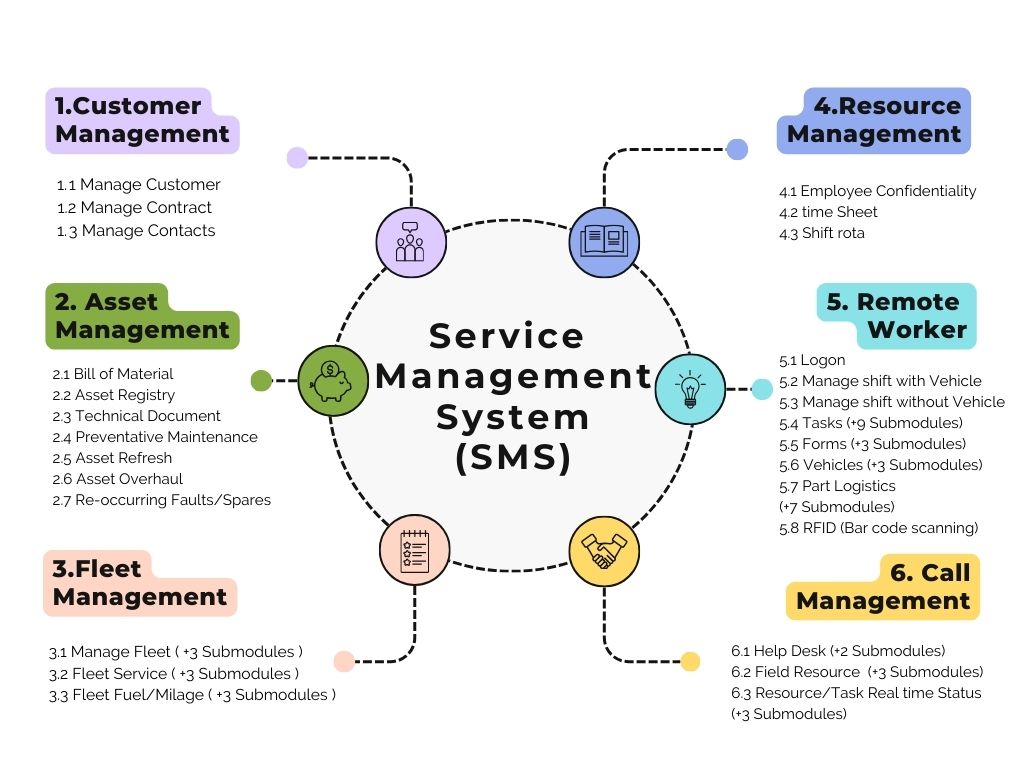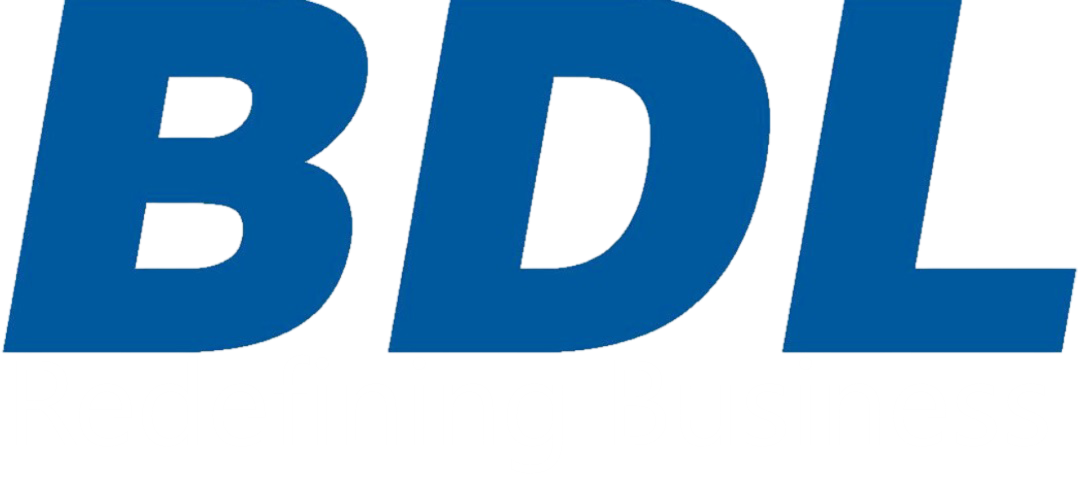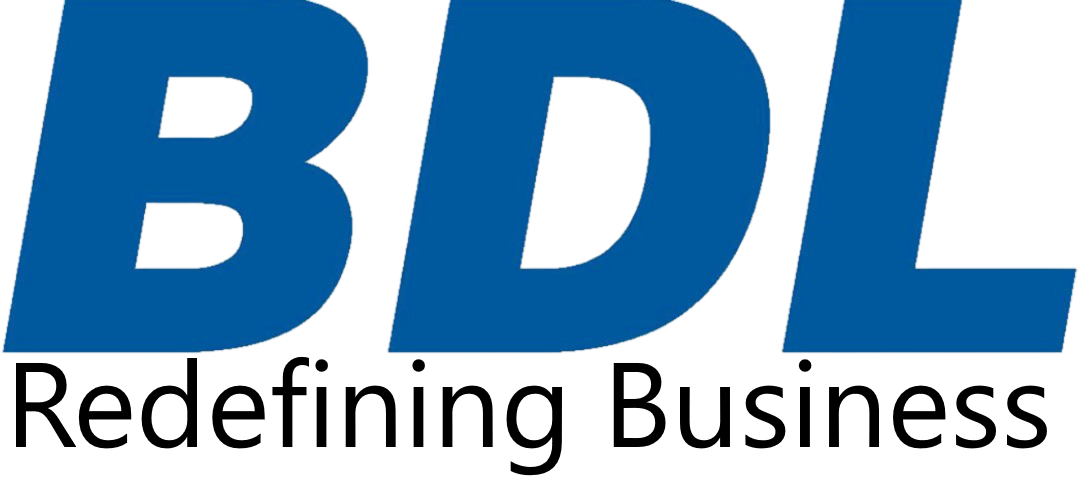


Service Management Software (SMS)
SMS is a comprehensive web-based software solution designed to support enterprise-wide operations in field service industries.
SMS streamlines the processes and information required by your technicians and staff while they are in the field. It is ideal for companies managing the installation and maintenance of systems or equipment.
The SMS application can generate various essential management reports.

Diagram & Modules
Service Management Software Modules

SMS comprises the following modules, which can be interconnected to provide a comprehensive solution or used individually:
Service Management Software
Call Management
Call Management is a web-based application featuring a call scheduler and resource optimiser that allocates calls to meet customer contractual obligations. Using advanced algorithms, the scheduling engine schedules calls in real time.
The Dynamic Scheduling Engine ensures that the most suitable engineer is assigned to each job, considering factors such as engineer skills, tools, shift patterns, SLAs, priorities, travel, and traffic delays. The engine provides optimal scheduling order and call allocation.
Call logging is driven by a predefined logical flow tailored to individual business requirements, eliminating human entry errors through an auto-validation process and reducing the need for highly skilled resources in call management.
The call scheduling order is established based on actual contractual performance and other business rule parameters. Additionally, contractual performance can be viewed in real time over the web in various formats, including graphs, maps, charts, and tables.
The Call Management module can be used as a stand-alone module or in combination with other Service Management modules, offering the benefits of a fully integrated system.

- The Dynamic Scheduling and Assigning engine identifies the most suitable resource based on skills, tools, service level agreements, contract performance, shift patterns, and other business priorities.
- A single screen displays the status of jobs, workload, and resource utilization in real time.
- Manual overrides allow for adjustments to automatic scheduling decisions based on client requirements.
- The system automatically reschedules in response to safety-critical calls, cancellations, or interruptions due to traffic delays, weather conditions, and more.
- With an open architecture, it can integrate with existing systems and is fully customizable to client requirements.
- Real-time visibility of all activities from call scheduling to call completion is provided in various formats such as maps, bar charts, and Gantt charts.
- At the touch of a button, users can view engineers’ progress in a specific area, contractual performance against groups of contracts, and the number of scheduled calls against a particular contract.
- Customers can easily define various parameters such as SLA and call priority.
- Automated scheduling and allocation of work to field resources in real time
- Increased efficiency in the call centre
- Identification and automatic management of SLA violations
- Elimination of non-productive time and minimized overtime working
- Ability to offer "committed" appointments against known resource availability
- Increased efficiency in the call center
- Increased field productivity
- Improved customer service levels
- Improved management control and visibility
Service Management Software
Customer Management
Customer Management is a web-based application designed to maintain and manage
multiple customer contracts (SLAs), system availability, service coverage, response
times, bonuses and abatements, call priorities, preventive maintenance targets,
automatic renewal tracking, and preventive maintenance scheduling. It also stores
contact information, including location details, to support business operational needs.
The data collected in this module enables the call scheduler engine to establish the
call scheduling order based on contractual requirements, priority, and other scheduling
parameters. Once the order is established, calls are allocated to the appropriate resources.
What sets our system apart is that the contractual information entered in this module
assists the call scheduler in generating the scheduling order when a call is logged,
rather than relying on call centre personnel to provide the scheduling order.
The Customer Management module is a powerful tool that can be used as a stand-alone
module or in combination with other Service Management System modules, providing the
benefits of a fully integrated system.

- This module allows customers to define Service Level Agreements (SLAs) and targets based on customer, contract, site, and model, incorporating performance metrics such as system availability and response and fix times, within a customizable time frame.
- Customers can set priorities based on contract, site, and model with user-defined time frames. Targets can also be established based on device reliability; if a device or group of devices exceeds failure targets, the system automatically prioritizes the call as high priority.
- Special days can be defined for specific sites, overriding the predefined performance regime and applying a special performance regime where the site becomes service-affecting or non-service-affecting.
- Customers can input payment-related information, including bonuses and abatements, allowing the system to calculate the total payment based on the performance achieved during that period.
- Additionally, customers can group similar assets or asset groups within single or multiple locations into different zones, which the scheduler engine can prioritize according to the customer-defined priorities.
- Customer details and contracts are easy to define and manage.
- Real-time performance tracking of each contract is possible using the SLA parameters set in the customer module.
- Call details are validated against customer data to eliminate errors.
- There is no need to rely on highly skilled call centre personnel to manage calls.
- Business rules and performance targets can be easily defined and managed.
- Cost savings are achieved by streamlining SLA administration.
- Compete more effectively with minimal resources.
Service Management Software
Asset Management
Asset Management is a web-based application that enables companies to enter and
maintain asset details, and manage asset-related activities for operational and
management personnel.
This module allows for the generation of plans for preventive maintenance, overhauls,
and asset refresh programs based on historical information and contractual requirements.
The generated plans are then forwarded to the Call Management module for scheduling.
Asset Management includes an Asset Register and an Asset Tracker. The Asset Register
records all serialized parts against the Bill of Material, while the Asset Tracker
logs all device movements between locations, providing real-time control over assets.
This information helps identify and rectify recurring faulty devices and parts.
The module records comprehensive information for each asset, including physical location
descriptions, drawings, technical information, inspection checklists, method statements,
special tools needed, expected results, and maintenance history.
A unique feature of this application is its ability to validate call logs against specific
models, model numbers, and expected faults, preventing incorrect data from being passed to
the Call Management Scheduler.
The Asset Management module can be used as a stand-alone module or in combination with other
Service Management modules, offering the benefits of a fully integrated system.

- When a call is logged, the Asset Management module validates the asset and the device at the fault's origin, reducing the need for skilled and trained resources in the call centre.
- Each asset type is predefined with possible symptom codes, cause codes, and action codes, along with an estimated time to complete (ETC), assisting the call scheduler in managing the workload.
- Preventive maintenance and other regular maintenance schedules can be automated to meet contractual obligations.
- The history of any asset or device movement and its current location can be viewed in real-time.
- Information from the Bill of Material (BOM) checks the validity of any part ordered by an engineer, preventing incorrect or improper parts from being ordered. When a device is upgraded, the BOM must be updated simultaneously to maintain data integrity.
- Asset Management prevents logging calls against incorrect assets, saving both time and money.
- This module displays only relevant parts for selection, referencing the Bill of Materials.
- The recurring fault functionality records and identifies faulty parts or devices early, allowing them to be removed from the system.
- Routine maintenance work can be scheduled annually in advance, eliminating the need for repetitive planning throughout the contract period.
- The current location and history of assets can be viewed using various search criteria.
- Part usage is maximized, reducing inventory costs.
Service Management Software
Resource Management
Resource Management is a web-based application that allows companies to
input and maintain resource details and manage resource availability,
skills, knowledge, and other relevant information for operational and
management personnel.
It is designed to assist service organizations in planning shift patterns,
man-hours, holiday allocations, overtime requirements, auto time sheet approval,
and automated rota generation, all while considering working time directives,
business rules, and procedures.
The key function of this module is to provide the Call Management module with
the necessary resource-related information, enabling the auto-assignment of
calls to the best possible resource. It also serves as an interface between
a legacy system and the Call Management module, facilitating the auto-assignment process.
The Resource Management module can be used as a stand-alone module or in
combination with other Service Management modules to provide the benefits
of a fully integrated system.

- Provides the capability to gather and maintain resource details for daily departmental and operational needs.
- Generates various shift patterns in accordance with working time directives to meet operational requirements.
- Manages resources' skills, tools, certificates, and permits.
- Captures and maintains information on resources' operational areas, teams, departments, and field locations.
- Manages various tasks such as holidays, sick leave, meetings, and training based on business rules.
- Utilizes the collected information to generate time sheets, rotas, and task diaries to meet employee and operational needs.
- Multi-skilled resources operating on various shift patterns can support customers with multiple contracts across different locations, managed effortlessly over a 24x7 period.
- Resource holiday, sick leave, meeting, and training requests can be automatically authorized based on predefined business rules, with only exceptions requiring manual approval.
- All activities during shift times are tracked by the system against predefined project codes, generating an automated time sheet for each resource.
Service Management Software
Fleet Management
Fleet Management is a web-based application that allows companies to enter and
maintain fleet details, manage fleet availability, and track all maintenance
information for operational and management personnel.
This module provides service organisations with visibility into available vehicles
for operational needs, fuel usage, vehicle usage, accidents, routine maintenance,
traffic offences, legal requirements, real-time GPS visibility, vehicle payments,
and compliance with lone worker regulations.
A key function of this module is to provide fleet-related information to the Call
Management module, enabling the automatic allocation of calls to the best resource
with the appropriate vehicle.
The Fleet Management module can be used as a stand-alone module or in combination
with other Service Management modules for a fully integrated system.

- The Fleet Management notification facility monitors and alerts users about tasks that need to be completed.
- It notifies users of statutory requirements in advance and sends automatic reminders via email or text.
- It provides real-time management information.
- It manages contractual and financial obligations, such as renewals and payments.
- It increases visibility into vehicle and fuel misuse.
- Integrates with any existing legacy systems.
- Maintains historical data for legal and commercial purposes.
- Enhances productivity and reduces administrative time, lowering overall fleet costs.
- Identifies parts and vehicle warranty claims to save money.
- Minimises fuel and vehicle misuse.
- Provides a detailed audit trail of vehicles and employees to comply with Duty of Care legislation.
- Offers a scalable solution suitable for companies of any size.
- Provides real-time information across the organisation.
- Offers various management reports for efficient and effective fleet monitoring and management.
Service Management Software
Remote Worker
Remote Worker is a form-based application designed for both online and offline use,
serving as an information carrier between field staff and back-office systems via a PDA.
Continuous data updates from mobile field staff allow the SMS scheduling engine to
automatically update job statuses in real-time, without manual intervention by call
centre staff.
Remote Worker provides field resources with critical real-time information. Field staff
can view service history, accept or reject jobs, send and receive messages, capture customer
signatures, update job statuses, and manage spare parts. The solution also provides route
directions to field staff, enhancing service levels by giving customers real-time job information.
The Remote Worker module can seamlessly integrate with any existing business applications.
It can be used as a stand-alone module or in combination with other Service Management modules
for a fully integrated system.

- Real-time optimisation and response to changing events and job updates from the field.
- Users can submit their work and non-work-related requests, such as breaks, holidays, training, and planned or unplanned sickness, via the "Remote Worker" PDA.
- Data transfer is fully secured using encryption and sent in a compressed format to minimize costs.
- The application is authenticated and can be remotely disabled if necessary. Based on business requirements, the PDA can be configured to auto-lock after a set number of incorrect username and password attempts.
- The application is form-based and operates both online and offline.
- This module includes additional features that allow users to record in real-time any incidents related to health and safety, devices, and vehicles, ensuring compliance with the company's health and safety and quality procedures.
- Users with assigned vehicles can record real-time details about the vehicle's fuel usage, breakdowns, and start and end shift mileage, which will automatically update the "Fleet Management" module.
- Reduces service lead times leading to improved customer satisfaction and loyalty.
- Empower your field workforce.
- Improve accuracy of field data in real time.
- Faster response times.
- Real-time updating of data shared across enterprise.
- Call center resources can be used in different areas of the business as there is no requirement to re-enter the field data.
- Reduces administrative costs associated with time-consuming paperwork and phone calls.
- Complies with Alone Worker H&S Legislation.

